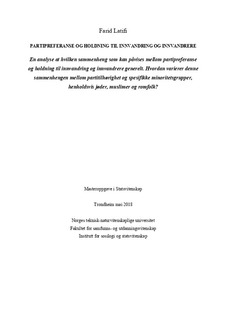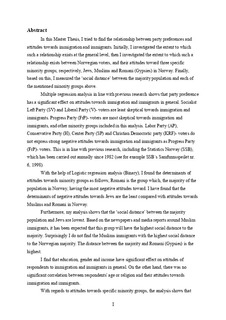| dc.description.abstract | In this Master Thesis, I tried to find the relationship between party preferences and attitudes towards immigration and immigrants. Initially, I investigated the extent to which such a relationship exists at the general level, then I investigated the extent to which such a relationship exists between Norwegian voters, and their attitudes toward three specific minority groups; respectively, Jews, Muslims and Romani (Gypsies) in Norway. Finally, based on this, I measured the ‘social distance’ between the majority population and each of the mentioned minority groups above. Multiple regression analysis in line with previous research shows that party preference has a significant effect on attitudes towards immigration and immigrants in general. Socialist Left Party (SV) and Liberal Party (V)- voters are least skeptical towards immigration and immigrants. Progress Party (FrP)- voters are most skeptical towards immigration and immigrants, and other minority groups included in this analysis. Labor Party (AP), Conservative Party (H), Center Party (SP) and Christian Democratic party (KRF)- voters do not express strong negative attitudes towards immigration and immigrants as Progress Party (FrP)- voters. This is in line with previous research, including the Statistics Norway (SSB), which has been carried out annually since 1982 (see for example SSB´s Samfunnsspeilet nr. 6, 1998). With the help of Logistic regression analysis (Binary), I found the determinants of attitudes towards minority groups as follows; Romani is the group which, the majority of the population in Norway, having the most negative attitudes toward. I have found that the determinants of negative attitudes towards Jews are the least compared with attitudes towards Muslims and Romani in Norway. Furthermore, my analysis shows that the ‘social distance’ between the majority population and Jews are lowest. Based on the newspapers and media reports around Muslim immigrants, it has been expected that this group will have the highest social distance to the majority. Surprisingly I do not find the Muslims immigrants with the highest social distance to the Norwegian majority. The distance between the majority and Romani (Gypsies) is the highest. I find that education, gender and income have significant effect on attitudes of respondents to immigration and immigrants in general. On the other hand, there was no significant correlation between respondents' age or religion and their attitudes towards immigration and immigrants. With regards to attitudes towards specific minority groups, the analysis shows that education, age and religion have a significant effect on attitudes of respondents towards Jews. On the other hand, the analysis shows that, only education and age have significant statistical effect on attitudes towards Muslims and Romani. | nb_NO |

